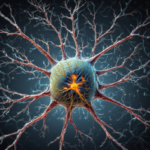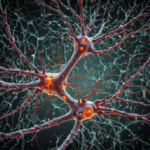Book Link 20 Video: The Chemical Mind
<back next> — index
Introduction
The way our brain works affects how we think and feel. Neurons, which are like tiny messengers in our brain, use chemicals to talk to each other. It’s kind of like a messaging system. These chemicals, called neurotransmitters, help our brain cells communicate. At the same time, our body has hormones that also affect how our brain works and how our body functions.
In this lesson, we’ll learn about these messengers in our brain, called neurons, and the chemicals that help them communicate. We’ll also talk about how hormones can change how we feel and how our body works. By understanding these things, we can start to see how our brain and body are connected and how they affect our everyday experiences.
Download a 90-page pdf from this site’s biology curriculum with details and diagrams beyond the scope of this web page.
Section 1: Neurons and How They Work
Neurons are also called nerve cells. Nerve cells have a soma, dendrites, and axons. The soma of a nerve cell has the same organelles as other cells. The soma contains a nucleus, mitochondria, etc. But the dendrites and axons are extra parts of a nerve cell. Dendrites branch out from the soma. Axons are long, tail-like extensions from the soma.
 Neurons are the building blocks of the nervous system and come in three major classes. These are sensory neurons, motor neurons and interneurons.
Neurons are the building blocks of the nervous system and come in three major classes. These are sensory neurons, motor neurons and interneurons.
As already menntioned, the parts of a neuron are called soma, dendrites, and axon. Each class of neurons have soma, dendirites and axons. But the configuration and arrangement of these parts provide for unique abilities for each major type.
 Sequences of neurons almost touch each other, but not quite. The small gap between neurons is called a synapse gap. When an signal comes through a neuron, a neurotransmitter chemical moves from it to the next one.
Sequences of neurons almost touch each other, but not quite. The small gap between neurons is called a synapse gap. When an signal comes through a neuron, a neurotransmitter chemical moves from it to the next one.
That chemical does not stay bonded to the receiving neuron though. The chemical returns to it’s original neuron and is reaabsorbed. The returning of the neurotransmitter chemical to is called reuptake.
There are different types of neurotransmitters that play crucial roles in neuronal communication:
- Acetylcholine: Involved in muscle movement, REM sleep, attention, and arousal.
- Dopamine: Associated with learning, movement, and pleasurable emotions.
- Endorphins: Natural opiate-like neurotransmitters linked to pain control and pleasure.
- Excitatory neurotransmitters: Increase the likelihood of a neuron acting.
- GABA (Gamma-aminobutyric acid): Producing a calming effect.
- Norepinephrine: Aids in controlling alertness and arousal to stress.
- Serotonin: Influences mood, hunger, and sleep.
In combination, neurons and neurotransmitter chemicals send signals throughout the body causing motion and emotion.
A few key points are that neurons in the nervous system communicate using electrical impulses, allowing for fast communication within the body. Neurons communicate through synapses using chemicals (neurotransmitters). Neurons typically target specific cells or groups of cells rather than large groups of unrelated cells. Neurons are connected to other cells through synapses. Overall, the nervous system involves the brain, spinal cord, and peripheral nerves.
Section 2: Important Chemical Messengers
Endorphins: The Feel-Good Chemicals
Excitatory Neurotransmitters: Getting Neurons Fired Up
Norepinephrine: The Alertness Hormone
GABA (Gamma-aminobutyric acid): The Calming Signal
Serotonin: The Mood and Sleep Regulator
Acetylcholine: The Messenger for Muscles and Memory
Dopamine: The Key to Learning and Pleasure
Section 3: The Endocrine System and Its Role
What is the Endocrine System?
The Glands of the Endocrine System and Their Jobs
How the Nervous and Endocrine Systems Diffe